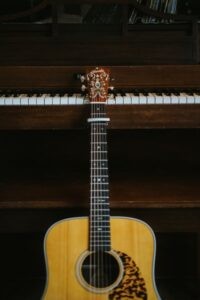Choosing between learning the guitar and piano can be a daunting task for aspiring musicians. Both instruments offer unique rewards and challenges. This guide delves into the complexities of each, comparing them across various factors to help you determine which might be easier for you to learn.
Song Learning: Guitar Takes the Lead
Learning simple songs, focusing on chords and strumming patterns, is generally quicker on the guitar. Basic chord shapes and strumming techniques can be grasped within hours, allowing beginners to play recognizable tunes relatively quickly. The physical layout of guitar chords often restricts accidental incorrect notes, providing a built-in advantage for beginners. Piano, while allowing for quick chord learning, benefits from a foundational understanding of music theory for long-term progress and improvisation.
Instrument Layout: Piano’s Simplicity Wins
The piano boasts a linear and consistently patterned keyboard, with lower notes on the left and higher notes on the right. This intuitive layout makes it easier to visualize scales and understand musical relationships. The guitar’s fretboard, while logical, presents a steeper initial learning curve with its six strings and multiple fret positions requiring more complex finger coordination.
Beginner Techniques: Piano Offers a Gentler Start
Early guitar playing often involves pressing strings firmly, potentially causing finger discomfort until calluses develop. Coordinating strumming and chord changes simultaneously adds another layer of complexity. Piano playing, while requiring finger dexterity, is generally less physically demanding for beginners, allowing for a more comfortable initial learning experience.
Intermediate Techniques: Both Pose Challenges
At the intermediate level, both instruments present unique challenges. Guitarists grapple with intricate strumming patterns, picking techniques, and mastering barre chords. Pianists face the demands of coordinating two hands independently across a larger keyboard range, often playing complex melodies and harmonies simultaneously.
Learning for Children: Piano’s Advantage
For young children, the piano’s ease of producing sound and the lack of initial finger pain make it a more accessible instrument. The piano’s visual and tactile simplicity allows for earlier melodic exploration and quicker gratification. While the guitar might seem appealing, the physical demands and coordination required can be challenging for smaller hands and developing motor skills.
Self-Teaching: Guitar’s Accessibility
The guitar’s lower initial barrier to entry makes it more conducive to self-teaching. Numerous online resources, chord diagrams, and tablature (a simplified notation system) facilitate independent learning. While piano self-teaching is possible, a stronger foundation in music theory is often beneficial, making guided instruction more advantageous.
Playing with Others: Guitar’s Portability
The guitar’s portability makes it the clear winner for playing with friends or in informal settings. Its acoustic nature eliminates the need for amplification in many situations, fostering spontaneous musical gatherings. The piano’s size and maintenance requirements limit its mobility.
Maintenance and Affordability: Guitar Wins
Guitars generally require less maintenance and are more affordable than pianos. Tuning a guitar is relatively simple and can be done by the player, while pianos require professional tuning. While entry-level keyboards offer a cost-effective alternative to acoustic pianos, they often lack the nuanced touch and feel of the real instrument.
The Verdict: It Depends
While the guitar is generally considered easier to learn initially, the “easier” instrument ultimately depends on individual learning styles, goals, and preferences. The piano offers a stronger foundation in music theory and potentially translates to learning other instruments more easily. The guitar provides quicker initial gratification and portability. Consider your priorities and long-term musical aspirations when making your decision.

